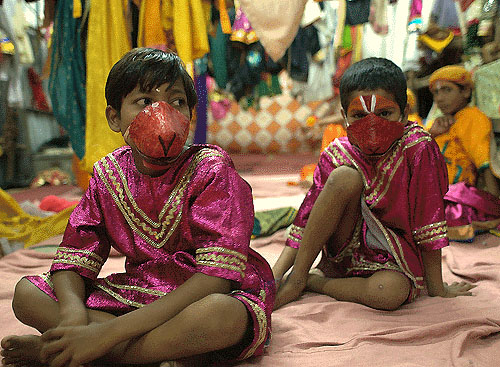Miracle Plays of Mathura - Ramlila, Part 4
BY: SUN STAFF

Sita devi
Photo by Elishams
Apr 26, CANADA (SUN) — The last in a four-part exploration of the Ramlila.
In costuming for the Ramlila, each North Indian community follows its own fancies, guided only by a few generally shared conceptions. One of these universal notions is that murky colors are appropriate for demonic beings. Everywhere, Ravana and his henchmen are seen in blue or black clothing. The faces of the lesser demons are blackened with soot. Ravana's ten-headedness is always somehow represented, but the patterns of headgear differ greatly from community to community.
The general intention in designing the dress of Rama is that he should be made to look like a king. But since the conceptions of royalty in the popular mind are vague, the results are various. In some towns Rama wears a coga. The costume worn in Mathura is a richly embroidered red velvet coat reminiscent of an old style of Western court dress. Sita wears her distinctive coronet, called a candrika, and a nose pendant (bulak) of pearl.

Photo by Elishams
The head-dress of Rama, here as everywhere, is a high cylindrical crown of a type peculiar to Himself. A white feather (turra) is fixed at its forward peak, and at the very top there rises a spade-shaped crest called kirit. Major protrusions from the right and left sides of the headgear are said to represent earrings (kundal). A tassel of strung pearls dangles from each of these ear ornaments. A halo (tej) is attached to the rear of the crown. The lower border of the crown is fringed with a string of pearls. The dots and lines of sandalwood paste which often ornament the face of the actor (commonly known as gopi dots) represent the face ornamentation of the Surabhi cow. The tilak seen worn in the middle of the forehead by Mathura actors is of the pattern peculiar to members of the Srivaishnava or Ramanuja Sampradaya.
There is also great local variation in stage design. No single structure or layout can be called the Ramlila stage. Sine audiences sit upon mats on the ground, performances remain passably visible even when the stage is only a rectangle of earth under the open sky; therefore communities sometimes do not trouble to put up any sort of erected stage. When elevated and covered platforms are built, their function is not always to provide a central floor for the action. They may represent specific fortresses, palaces, or other buildings that serve only occasionally as the scene of some part of the panoramic action.
It is a widely recognized principle of staging that, whenever a change of geographical setting occurs in the story of the Ramayana, the scene of acting must undergo a complete shift to indicate the change of place. At such times, a move is made to a new arena, usually in another part of the town.

Ramlila at Bir Mandir
Photo by Elishams
The Mathura players perform during their season in six different localities within their city. The events set in Ayodhya and Janakpur are enacted on a stage erected in a large open-air grain market in the heart of the Mathura business district. The heaven of Vishnu to which the gods go to plead for help against Ravana is set-up in a nearby bazaar. Visvamitra's hermitage is identified with the grounds of a local temple. A landing place on a bank of the Yamuna River becomes Prayag, where Rama's famous dialogue with Kevata the ferryman is re-enacted. Citrakut has yet another location, and the jungle scenes another. At most of these places much labor is expended in preparing special facilities for players and spectators.
In Vrindaban some years ago, a group of young men gained control of the Ramlila who were convinced that their audiences had no real need for such literal and costly representation of the various localities of the Ramayana. Defying the convention of the shifting stage, they began a tradition of holding performances night after night in a single arena on the grounds of the Temple of Rangji. They give token recognition to the older principle, however, by enacting their various scenes now at one end, now at another, of the long strip of grass that is their stage.

Hanuman's Monkey Army
In providing whole new theaters at each major change of scene, the Ramlila is lavish, but it is economical in its use of scenery and stage properties. Excepting a solitary throne in palace scenes, the stages are practically bare. Because they are bare, they are extremely adaptable. If the plays are currently running in the spot designated as Ayodhya, the stage can, with trifling changes or none in stage equipment, represent any and every part of Ayodhya. When, soon afterward, another stage comes into use in the jungle scenes, it serves as the setting for every action said to have taken place in a thousand miles of territory. One of its borders represents the site of Rama's peninsular headquarters, and the other side, twenty feet away, includes the seat of Ravana in the throne room of his palace in Ceylon. This imaginative way of interpreting and using the stage area manifested itself in facilities of quite different appearance in the three cities of the author's direct observation.
As described by author Norvin Hein in his book, The Miracle Plays of Mathura, the Ramlila is as much a part of the social fabric of North India as any theatrical or dramatic performance in the land. Loved by citizens of all ages, the mood of cooperative community that is created by Ramlila performances brings all members of the local society together. The great sense of piety demonstrated by the Ramlila performers stands as inspiration and guide for community members the whole year through.

Going with Hanuman in Search of Sita
Photo by Elishams
